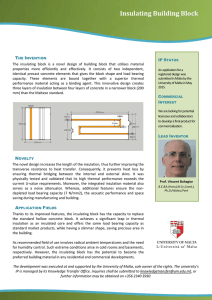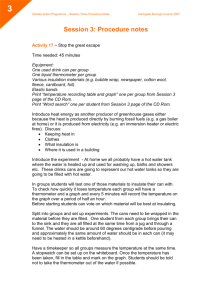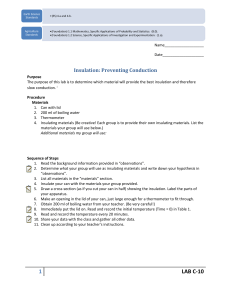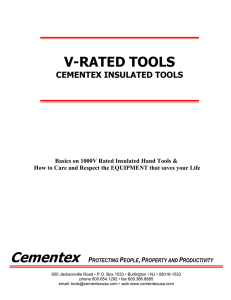Insulating Materials List
advertisement
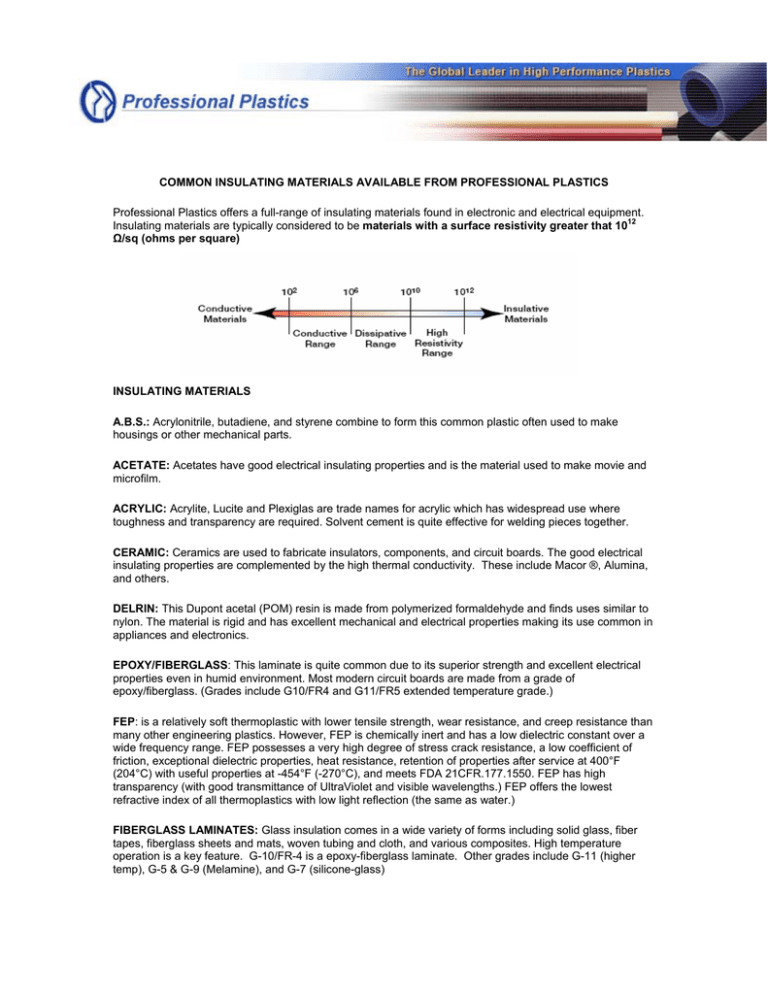
COMMON INSULATING MATERIALS AVAILABLE FROM PROFESSIONAL PLASTICS Professional Plastics offers a full-range of insulating materials found in electronic and electrical equipment. 12 Insulating materials are typically considered to be materials with a surface resistivity greater that 10 Ω/sq (ohms per square) INSULATING MATERIALS A.B.S.: Acrylonitrile, butadiene, and styrene combine to form this common plastic often used to make housings or other mechanical parts. ACETATE: Acetates have good electrical insulating properties and is the material used to make movie and microfilm. ACRYLIC: Acrylite, Lucite and Plexiglas are trade names for acrylic which has widespread use where toughness and transparency are required. Solvent cement is quite effective for welding pieces together. CERAMIC: Ceramics are used to fabricate insulators, components, and circuit boards. The good electrical insulating properties are complemented by the high thermal conductivity. These include Macor ®, Alumina, and others. DELRIN: This Dupont acetal (POM) resin is made from polymerized formaldehyde and finds uses similar to nylon. The material is rigid and has excellent mechanical and electrical properties making its use common in appliances and electronics. EPOXY/FIBERGLASS: This laminate is quite common due to its superior strength and excellent electrical properties even in humid environment. Most modern circuit boards are made from a grade of epoxy/fiberglass. (Grades include G10/FR4 and G11/FR5 extended temperature grade.) FEP: is a relatively soft thermoplastic with lower tensile strength, wear resistance, and creep resistance than many other engineering plastics. However, FEP is chemically inert and has a low dielectric constant over a wide frequency range. FEP possesses a very high degree of stress crack resistance, a low coefficient of friction, exceptional dielectric properties, heat resistance, retention of properties after service at 400°F (204°C) with useful properties at -454°F (-270°C), and meets FDA 21CFR.177.1550. FEP has high transparency (with good transmittance of UltraViolet and visible wavelengths.) FEP offers the lowest refractive index of all thermoplastics with low light reflection (the same as water.) FIBERGLASS LAMINATES: Glass insulation comes in a wide variety of forms including solid glass, fiber tapes, fiberglass sheets and mats, woven tubing and cloth, and various composites. High temperature operation is a key feature. G-10/FR-4 is a epoxy-fiberglass laminate. Other grades include G-11 (higher temp), G-5 & G-9 (Melamine), and G-7 (silicone-glass) HIGH IMPACT POLYSTYRENE (HIPS): has great dimensional strength, balanced properties of impact strength and heat resistance, is easily machined, and is relatively low in cost. Styrene is available in standard 48" x 96" sheets, or customer Sheets & Rolls. Also available in Conductive Grades upon request. KAPTON: Polyimide film has exceptionally good heat resistance and superb mechanical and electrical properties. Kapton tapes are fairly expensive but often indispensable. KAPTREX: Kaptrex is Professional Plastics brand name of Polyimide film (comparable to Kapton polyimide from DuPont) KYNAR: Kynar PVDF is a fluoropolymer with excellent chemical and abrasion resistance. It is readily machined and welded. MACOR: Macor® is a machinable glass ceramic material that posses outstanding engineering properties including low thermal conductivity which makes it an excellent insulator. Unlike other ceramics, Macor can be machined with ordinary metalworking tools. Macor is also a problem solving material combining the performance of a technical ceramic with the versatility of a high performance plastic. Macor has no porosity and when properly baked out, will not outgas. It is strong and rigid and, unlike high temperature plastics, will not creep or deform. Macor is also radiation resistant. MELAMINE: Melamine laminated with woven glass makes a very hard laminate with good dimensional stability and arc resistance. (Grades G5 is the mechanical grade and G9 is the electrical grade.) MELDIN® 7001 (Unfilled Polyimide): offers superior mechanical properties & high chemical resistance. Meldin® 7001 is ideal for electrical and thermal insulating applications. More ductile than ceramics, and lighter weight than metals, Meldin® 7001 is a popular choice for structural parts in aerospace and other applications where metal replacement is desirable. Meldin® 7001 is an excellent replacement for Vespel® SP-1 MICA: Mica sheets or "stove mica" is used for electrical insulation where high temperatures are encountered. Thermal conductivity is high so mica insulators are useful for heatsinking transistors or other components with electrically conductive cases. Puncture resistance is good but the edges of the mica should be flush against a flat surface to prevent flaking. Mica finds uses in composite tapes and sheets which are useful to 600 degrees centigrade with excellent corona resistance. Sheets and rods of mica bonded with glass can tolerate extreme temperatures, radiation, high voltage, and moisture. This rather expensive laminate may be machined and it will not burn or outgas. NEOPRENE: Neoprene rubber is the material used for most wet suits. This black rubber is commonly used for gaskets, shock absorbers, grommets, and foams. NOMEX: Nomex is a Dupont aromatic polyamide with an operating temperature range over 220 degrees centigrade and with superb high voltage breakdown. It is an excellent choice for standardization since it outperforms many other materials. NORYL (PPO): Noryl EN265’s overall physical properties are excellent: low moisture absorption and heat resistance of 265 degrees F at 264psi combine to make Noryl a truly high performance material at very cost effective rates. Parts are easily machined to fill a variety of needs. Used in appliances, liquid handling equipment, and numerous other applications, Noryl serves many industries. Noryl is attacked by petroleum products, so knowing the environment which the Noryl part will be exposed to is vital. NYLON: Nylon has good resistance to abrasion, chemicals, and high voltages and is often used to manufacture electro-mechanical components. Nylon is extruded and cast and is filled with a variety of other materials to improve weathering, impact resistance, coefficient of friction, and stiffness. The drawback of Nylon is that it is very susceptible to moisture absorption. PEEK: (PolyEtherEther-Ketone) is a high performance engineering thermoplastic. PEEK grades offer chemical and water resistance similar to PPS (PolyPhenylene Sulfide), but can operate at higher temperatures. PEEK can be used continuously to 480°F (250°C) and in hot water or steam without permanent loss in physical properties. For hostile environments, PEEK is a high strength alternative to fluoropolymers. PEEK carries a V-0 flammability rating and exhibits very low smoke and toxic gas emission when exposed to flame. P.E.T.: Polyethylene terephthalate is a highly dimensionally stable thermoplastic with good immunity to moisture. This excellent insulator has a low coefficient of friction and is excellent for guides and other moving parts. Professional Plastics offers Ertalyte brand PET-P. P.E.T.G.: A clear, tough copolyester commonly used for durable "bubble-packs" or food containers. PHENOLICS: Phenolic laminated sheets are usually brown or black and have excellent mechanical properties. Phenolics are commonly used in the manufacture of switches and similar components because it is easily machined and provides excellent insulation. Phenolic laminates are widely used for terminal boards, connectors, boxes, and components. Various Types of Micarta Phenolic: CANVAS REINFORCED PHENOLIC - NEMA C per MIL-I-24768 TYPE FBM - NEMA CE per MIL-I-24768 TYPE FBG - Good mechanical and impact strength with contiunuous operating temperature of 250°F. LINEN REINFORCED PHENOLIC - NEMA L per MIL-I-24768 TYPE FBI- NEMA LE per MIL-I-24768 TYPE FEI- Good mechanical & electrical strength. Recommended for intricate high strength parts. Continuous operating temperature 250°F. PAPER REINFORCED PHENOLIC -NEMA X - Meets Mil-I-24768/12 -Meets LP-509 Type PBM. per MIL-I24768 PBG -tough laminate with a high impact resistance, excellent tensile, compressive and flexural strengths. Additional Paper Grades include XX, XXX and puching grades such as XP & XXXP. NYLON REINFORCED PHENOLIC - NEMA N-1 per MIL-I-24768 TYPE NPG- Superior electrical properties under humid conditions, fungus resistant, continuous operating temperature of 160°F. PFA (PerFluoroAlkoxy) offers similar properties to FEP, but is considered more of a premium resin. PFA is preferred when extended service is required in hostile environments involving chemical, thermal, and mechanical stress. PFA offers high melt strength, stability at high processing temperatures, excellent crack and stress resistance, a low coefficient of friction, and more than 10 times the Flex life of FEP. It has high resistance to creep and retention of properties after service at 500°F (260°C), with useful properties at 320°F (95°C). POLYCARBONATE (LEXAN® and MAKROLON®) These polycarbonates have excellent electrical insulating properties. Optical grades are available and the material is so tough that it meets ballistic requirements for impact resistance. Non-transparent grades are machined to make strong insulators, rollers, and other mechanical parts. POLYESTER (MYLAR): A strong material often used in film sheets and tapes for graphic arts and electronics. Those shiny balloons and "space blankets" are usually made from metalized Mylar. Mylar is also used as a dielectric in capacitors. POLYOLEFINS: Polyethylene is the lightweight, corrosion-resistant material used for various applications including food cutting boards. Different densities are available including; LDPE (Low Density Polyethylene), HDPE (High Density Polyethylene) and UHMW (ultra-High Molecular Weight) which offers superior toughness and wear-resistance. Polypropylene is another widely used polyolefin know for it’s excellent combination of corrosion-resistance, light weight and temperature performance. Polypropylene is available in a variety of colors and grades including fire-retardant. POLYSTYRENE: A clear insulator with superb dielectric properties. Polystyrene capacitors exhibit little dielectric adsorption and virtually no leakage. Liquid polystyrene or Q-dope is a low-loss coil dope used to secure windings and other components in RF circuits. POLYSULFONE is an amorphous high performance polymer characterized by excellent thermal properties, good resistance to inorganic acids and bases, and outstanding hydrolytic stability against hot water and steam sterilization. Polysulfone's resistance to detergents and hydrocarbon oils is very good, even at elevated temperatures under moderate stress levels, and it complies with the National Sanitation Foundation's potable wander standard up to 180 degrees F. NSF, FDA, USDA, 3A Dairy & USP Class VI Approved. POLYURETHANE: Polyurethane is another common polymer which features abrasion and tear resistance along with a host of desirable characteristics. Degrading little over time or temperature, polyurethane is popular in both commercial and consumer applications. PTFE (TEFLON): Teflon is an excellent high temperature insulation with superb electrical properties. Teflon tubing and wire insulation comes in a variety of colors and typically feels slippery. The insulation is impervious to the heat and chemicals normally encountered in electronics manufacturing but the material will "cold flow" so Teflon insulation is avoided where sharp corners or points are encountered. Laminated TFE circuit boards take advantage of Teflon's excellent microwave characteristics. Teflon emits a dangerous gas when exposed to extreme heat. White Teflon terminals are commonly used where extremely good insulation is required. The slick surface repels water so the insulation properties are fantastic even in high humidity. High quality I.C. sockets are made from Teflon to reduce leakage currents. Teflon and Teflon composite tapes with adhesive are available. PVC: Polyvinylcloride or PVC is perhaps the most common insulating material. Most wiring is insulated with PVC including house wiring. Irradiated PVC has superior strength and resistance to heat. PVC tapes and tubing are also quite common. Electrical and electronic housings are commonly molded from PVC. REXOLITE® 1422 & 2200: Rexolite® is a unique cross linked polystyrene microwave plastic. Rexolite® is often used for high-frequency circuit substrates, microwave components, and lenses with acoustic, optical and radio-frequency applications. Two different forms are available: Rexolite® 1422 and Rexolite® 2200 (2200 is a fiberglass reinforced version of 1422). REXOLITE 1422: Thermoset cross-linked styrene copolymer. Combination of good physical and excellent electrical properties including low loss and stable dielectric constant makes this material suitable for use in microwave lenses as well as for precision components. REXOLITE 2200: Thermoset cross-linked styrene copolymer with glass mat reinforcement to provide greater temperature stability and strength. Highly suited for missile and other applications where extreme cold, thermal shock and mechanical stress are encountered. Used principally for printed circuit boards. RYTON® polyphenylene sulfide (PPS) has a long standing reputation as a high performance engineering thermoplastic. With an exceptional degree of inherent thermal stability, dimensional stability, chemical resistance, and flame resistance, combined with excellent mechanical and electrical properties, Ryton PPS can provide superior performance over a broad range of critical design requirements. Ryton also possesses excellent processing characteristics necessary to meet demanding, high precision applications. Available in various grades. The most common grade is Ryton R4 (40% Glass-Filled) SILICONE/FIBERGLASS: Glass cloth impregnated with a silicone resin binder makes an excellent laminate with good dielectric loss when dry. (Grades include G7.). Also available in electrical sleeving. SILICONE RUBBER: A variety of silicone foam rubbers are available for insulating and cushioning electronic assemblies. Silicone rubbers exhibit a wish list of characteristics including superb chemical resistance, high temperature performance, good thermal and electrical resistance, long term resiliency, and easy fabrication. Liquid silicone rubbers are available in electrical grades for conformal coating, potting, and gluing. Silicone rubbers found in the hardware store should be avoided in electronic assemblies because they produce acetic acid. TECHTRON® (Unfilled PPS) offers the broadest resistance to chemicals of any advanced engineering plastic. They have no known solvents below 392°F (200°C) and are inert to steam, strong bases, fuels and acids. Minimal moisture absorption and a very low coefficient of linear thermal expansion, combined with stress-relieving manufacturing, make PPS ideally suited for precise tolerance machined components. Techtron® PPS is ideal for structural applications in corrosive environments. ULTEM® 1000 (standard, unfilled polyetherimide - PEI) - Ultem Sheets & Rods offer excellent chemical resistance, high dielectric strength, natural flame resistance, and extremely low smoke generation. Ultem provides exceptionally high mechanical properties and ease of fabrication including bonding make it an easy choice when exceptional performance is required. High strength and performs in continuous use to 340°F (170°C). 94-V-0 rated with low smoke KPSI. FDA, USDA, USP Class VI & NSF Approved (natural color only) VESPEL® SP-1 (Polyimide) is a high-performance polyimide offering a broad combination of temperature resistance, chemical resistance, mechanical toughness, natural lubricity,wear-resistance and insulation properties. DuPont Vespel SP-1 parts provide operating temperatures from cryogenic to 300°C (570°F), great plasma resistance, plus a UL rating for minimal electrical and thermal conductivity. Vespel ® SP-1 is the unfilled base resin grade. SP-1 provides maximum physical strength, elongation, and toughness as well as the best electrical and thermal insulation values. ELECTRICAL INSULATING PAPERS: A variety of insulating papers are available specifically designed for insulating electrical circuits. Rag and craft paper often called Transformer Paper is often used to separate windings in transformers or in applications where no sharp edges might poke through the relatively weak paper. Grey and tan are common colors. Vulcanized Fibre (aka Fishpaper) is a curious name referring to a grey cotton rag paper usually vulcanized and often laminated with Mylar. The Mylar may have paper on one or both sides and many thickness grades are available. Tear and puncture resistance are excellent and the thinner grades are easily cut with scissors. Other "sandwich materials" are available including 100% polyester laminates and are usually a distinct color. The paper/Mylar laminates resist soldering heat better since the paper doesn't melt and the Dacron/Mylar laminates resist moisture best. Laminates with thicker polyester centers are fashioned into insulating plates in many electro-mechanical devices. A typical application may be observed inside most older electrical timers where a printed and folded piece of laminated paper keeps the user's fingers away from the high voltage when adjusting the position of the on and off trippers. Papers made with temperature resistant nylon and/or glass weaves have excellent electrical properties and good temperature resistance. Thin sheets of epoxy-fiberglass usually green in color are commonly used for insulating PCB's and electronic assemblies with potentially sharp projections. Puncture resistance is superb even for sheets thin enough to be quite flexible. A simple clear polyester sheet is sometimes used for insulation but is offers far less puncture and temperature resistance than the laminates. The ordinary appearance may prove to be a liability also: one computer maker uses such a sheet to insulate the motherboard from the chassis and many novices have left this critical insulator out when reassembling their computer with disastrous results. Die-cut laminates look important and are easily printed. TAPES: Tapes are made from many of the above materials. Vinyl tapes are commonly used for wire insulation and are available in all the colors necessary for color coding. Mylar tapes are common in electronics: film capacitors often have a final wrap of yellow Mylar tape. Acetate tapes are used where good conformability is desired as when covering coils as is white cotton cloth tape. Glass cloth electrical tape with thermosetting adhesive (adhesive that permanently sets with temperature) is used to secure and protect heater windings or insulate components exposed to heat. Kapton, Teflon, and other insulators from the above list are used to make high performance specialty tapes for harsh temperature or chemical environment. FOAMS: Foams are available for both thermal insulation and mechanical / acoustical insulation. Choosing a foam for vibration damping can prove difficult. Many foams become stiff at cold temperatures and will "take a set" at elevated temperatures. Some foams may have excellent temperature characteristics but exhibit too much "spring" giving the assembly an unacceptable resonance. Evaluate several materials before choosingfoams are made from many of the insulating materials mentioned above. Some of the more common foams are listed below. NEOPRENE FOAM: Neoprene foam is often used for shock absorbing and vibration damping. POLYSTYRENE FOAM: Styrofoam is the white foam used in inexpensive ice chests and packing peanuts. It is an excellent insulator but cannot tolerate elevated temperatures. Professional Plastics offers a similar product called High Impact Polystyrene (H.I.P.S.) ( see details above ). We also offer cross-linked polystyrene (Rexolite) POLYURETHANE FOAM: Urethane foams are available in both rigid and flexible forms. The insulating properties are excellent and elevated temperature tolerance is good. Machined pieces of rigid polyurethane are often used as thermal insulators in electronic equipment. The soft foams are good for vibration and sound attenuation and are available with a wide variety of properties. SILICONE FOAM: Silicone foams provide excellent vibration damping characteristics and excellent high temperature performance and chemical resistance. VINYL FOAM: Vinyl foam has very little "spring" and is useful for vibration damping. ELECTRICAL INSULATING SLEEVING: These tubing products include Polyolefin (FP-301), PVC (T-105), Kynar (PVDF), Teflon (PTFE), FEP, Silicone Glass, and a wide variety of others. Call Professional Plastics at (888) 995-7767 or E-Mail sales@proplas.com Order Online at www.professionalplastics.com
